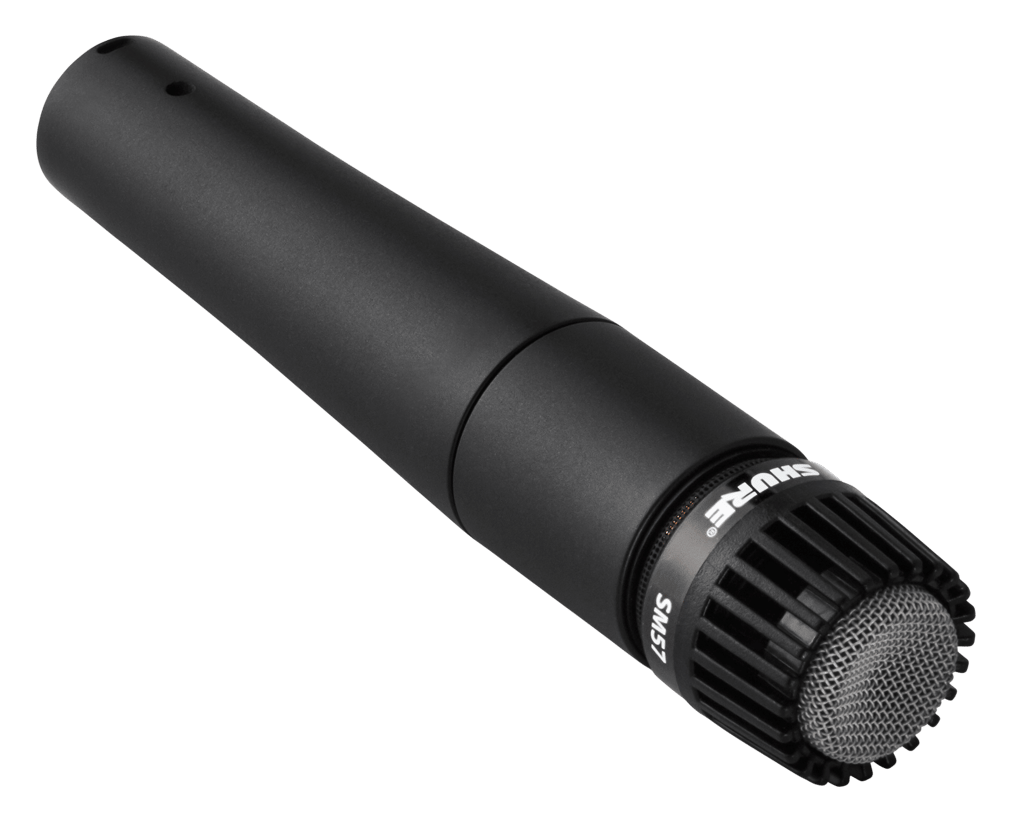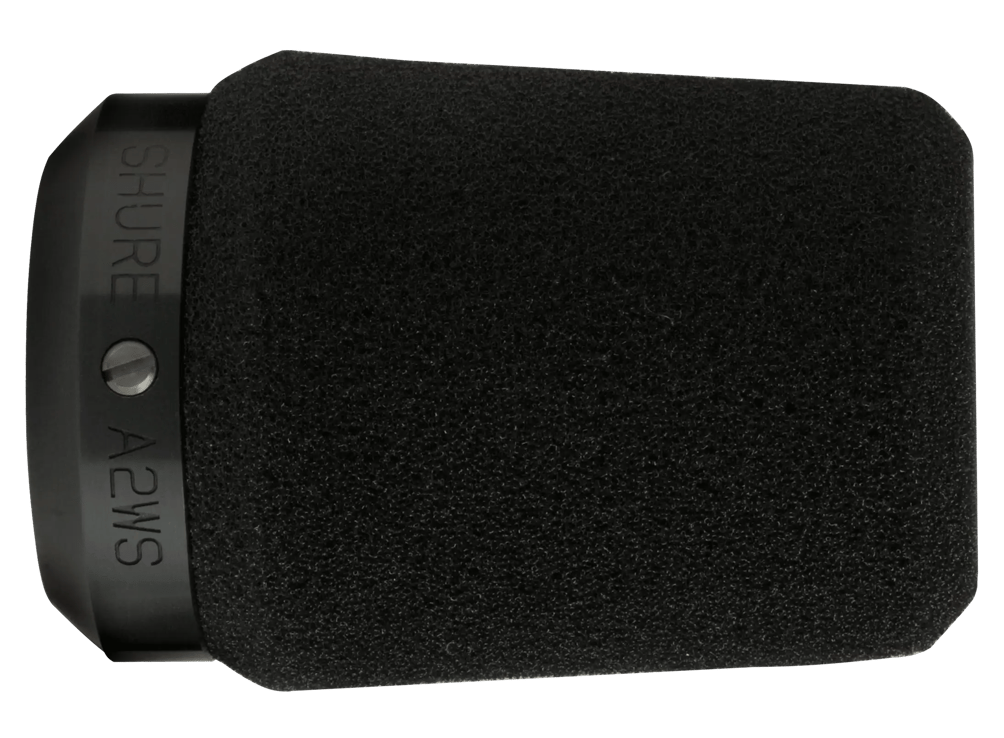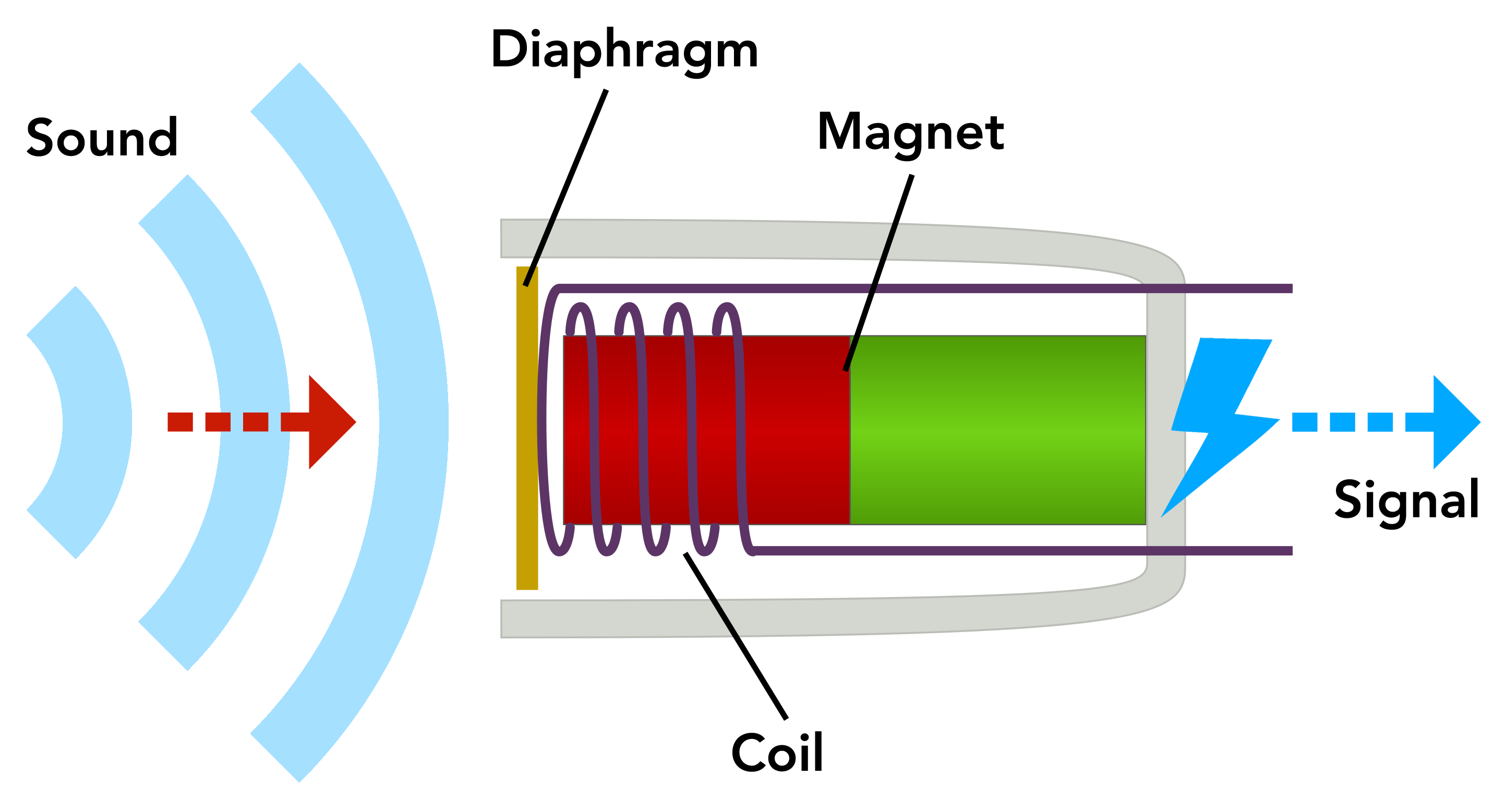. Shure SM57Guitar Cab Microphone Does Voiceovers Peter Kun Frary. .
|
The cardioid polar pattern of the SM57 focuses on sound near the front of the capsule, rejecting off-axis sounds such as AC rumble and traffic. The fact that the SM57 is a dynamic mic makes also it less prone to picking up off-axis noise than condenser mics. Why? The low sensitivity requires close placement to the sound source. |
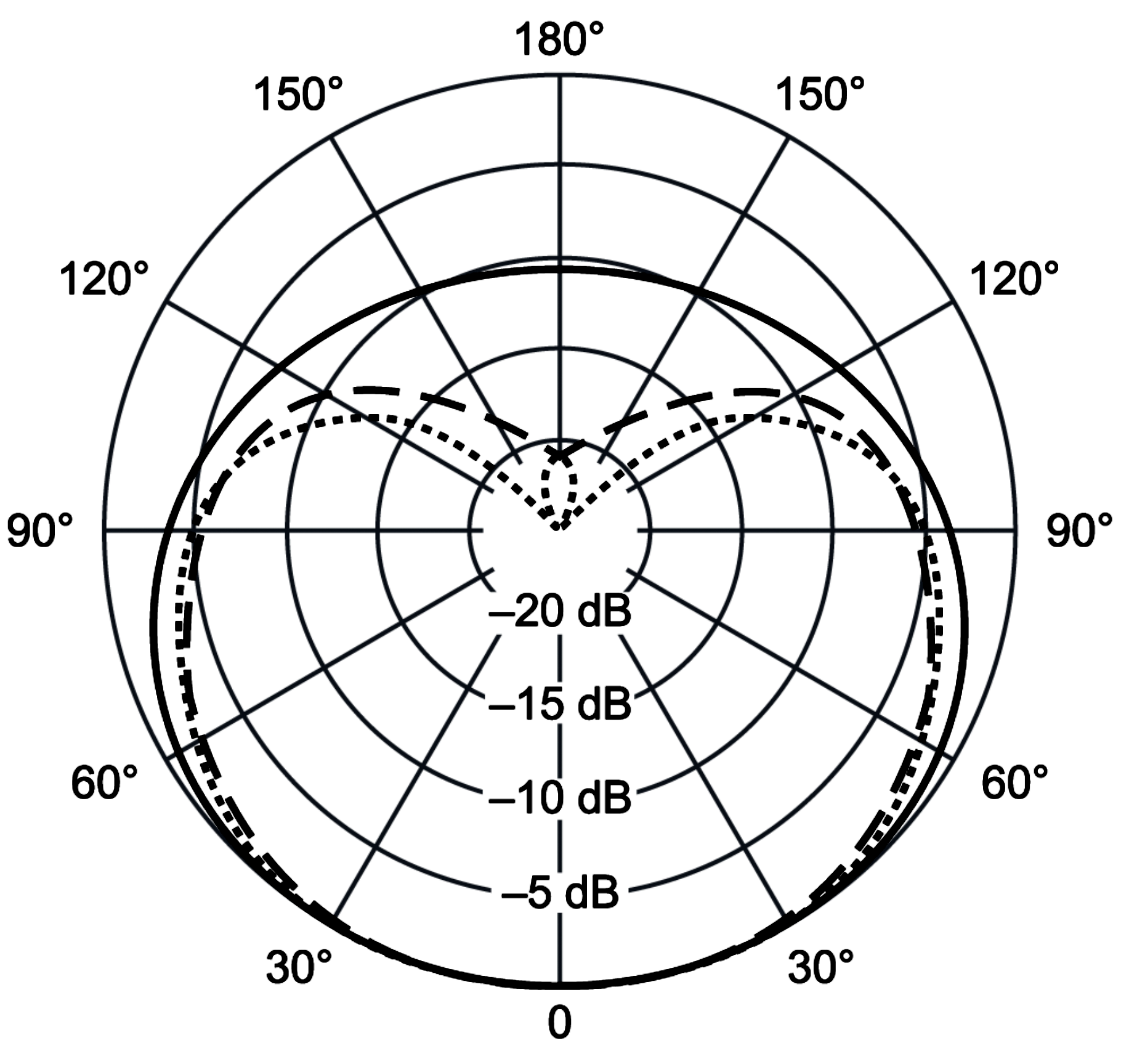 |
Frequency Response
Shure lists SM57 frequency response as 40 Hz to 15,000. Their official frequency response diagram shows a range of 40 Hz to 16,000 Hz with about -11 dB drop-off at 40 Hz and -8 dB at 16,000:
Shure SM57 Frequency Response | Image courtesy Shure
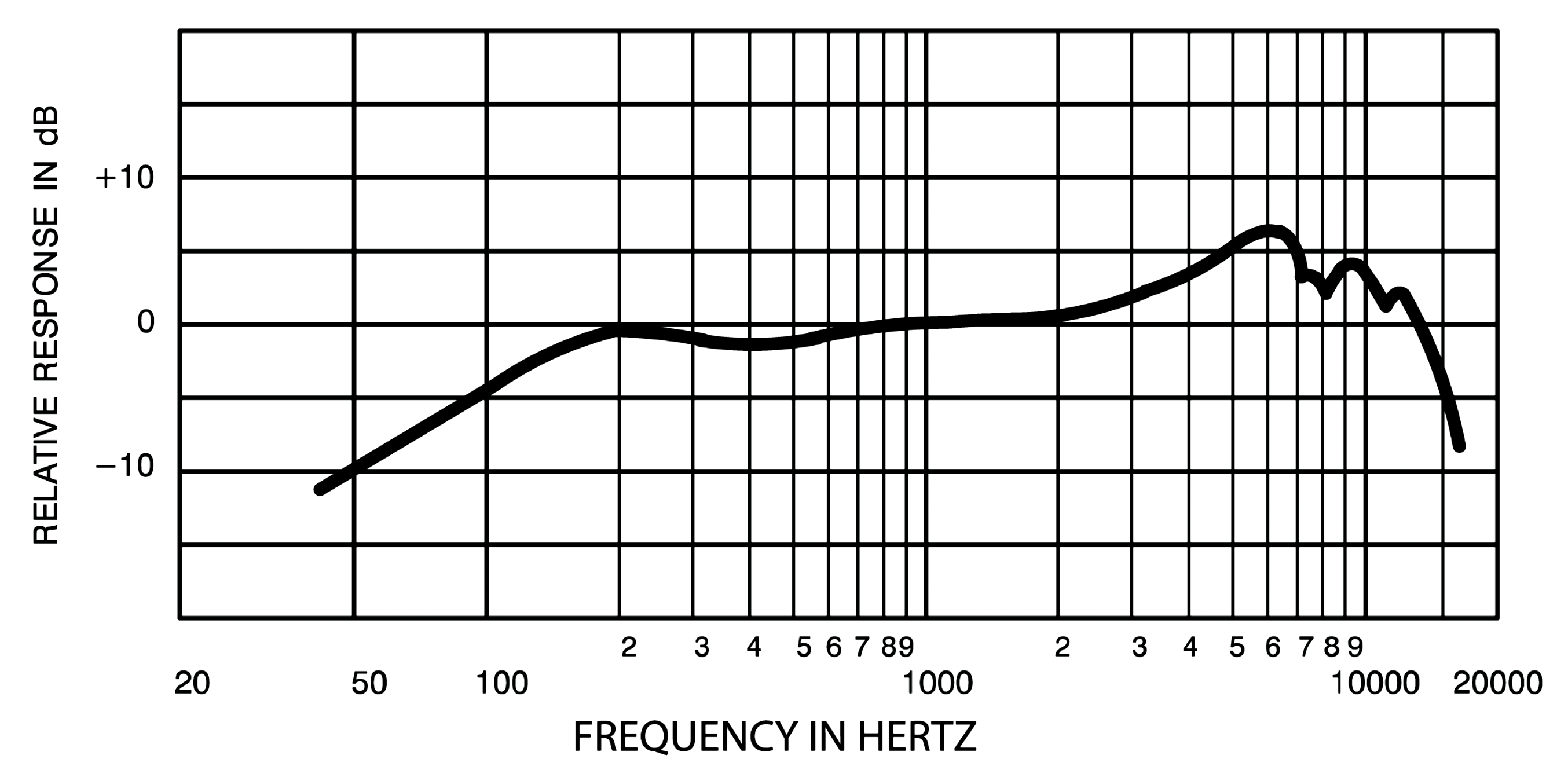
Plenty of range for spoken word and guitar cabs!
The closest relative of the SM57 is the SM58. It shares the same Unidyne III capsule and has a similar frequency response profile: 50Hz to 15,000Hz range with about -8 dB drop off at 50 Hz and -6 dB at 15,000 Hz:
Shure SM58 Frequency Response | Image courtesy Shure
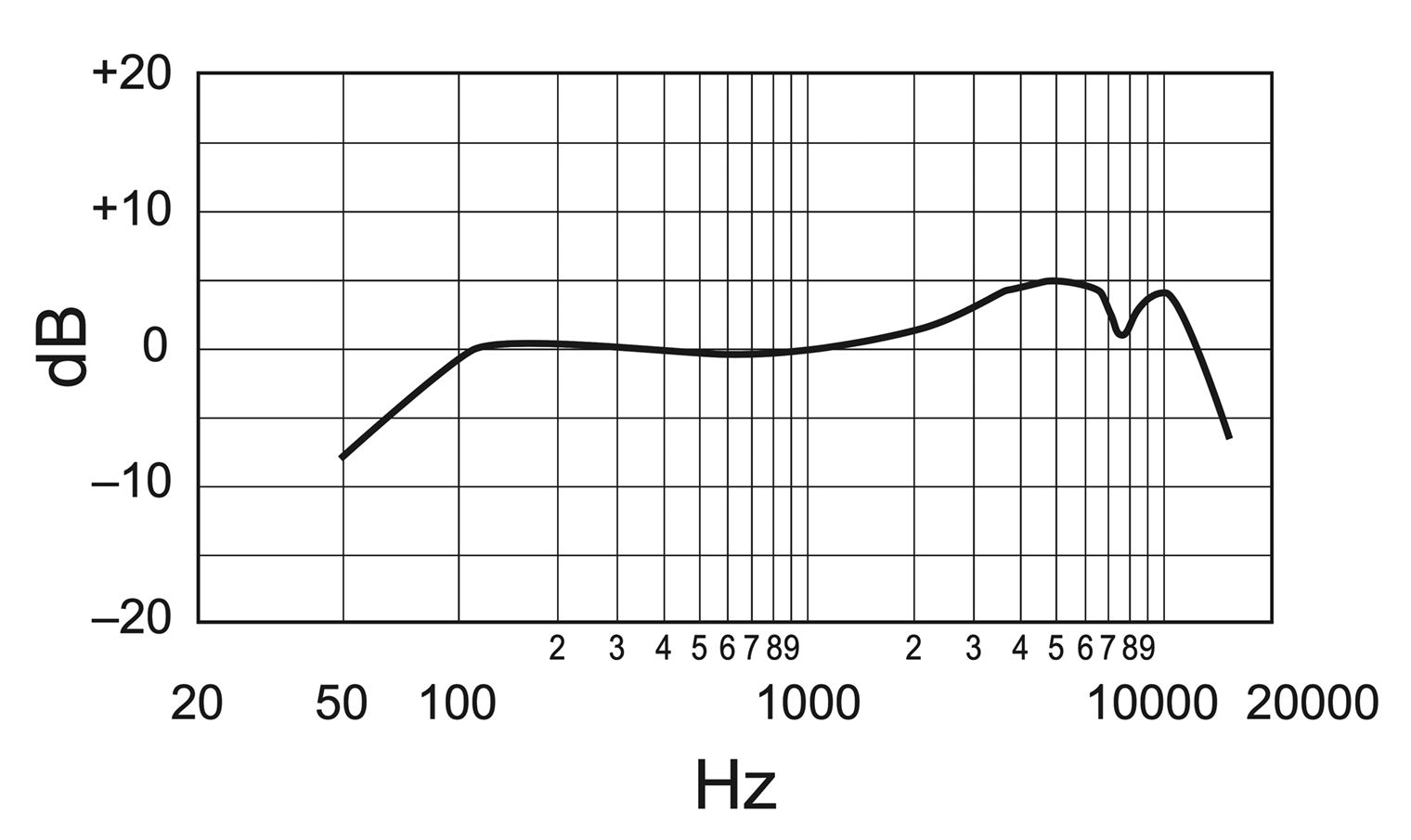
The SM57 has a little stronger boost in the highs whereas the SM58 sports a deeper EQ cut at about 7500 Hz, probably to reduce sibilance.
Shock Mount
The SM57 has an internal pneumatic shock mount for reducing handling noise. While the internal shock mount is helpful for stage use, it does little to nix vibrations and hum from my iMac and external hard drives.
The SM57 is too fat to fit Rycote shotgun shock mounts so I tried the Shure A55M Shock Mount Microphone Clip. The air filled rubber retaining ring is fast and easy to mount and dismount the mic—superior to a hard plastic clip. Looks nice too. It reduced vibrations a little but, ultimately, external hard drives need to be turned off when recording with a desk mounted boom arm.
Shure A55M | The Shure A55M Shock Mount Microphone Clip reduces vibrations and is easier to use than a hard plastic clip. | Image courtesy Shure
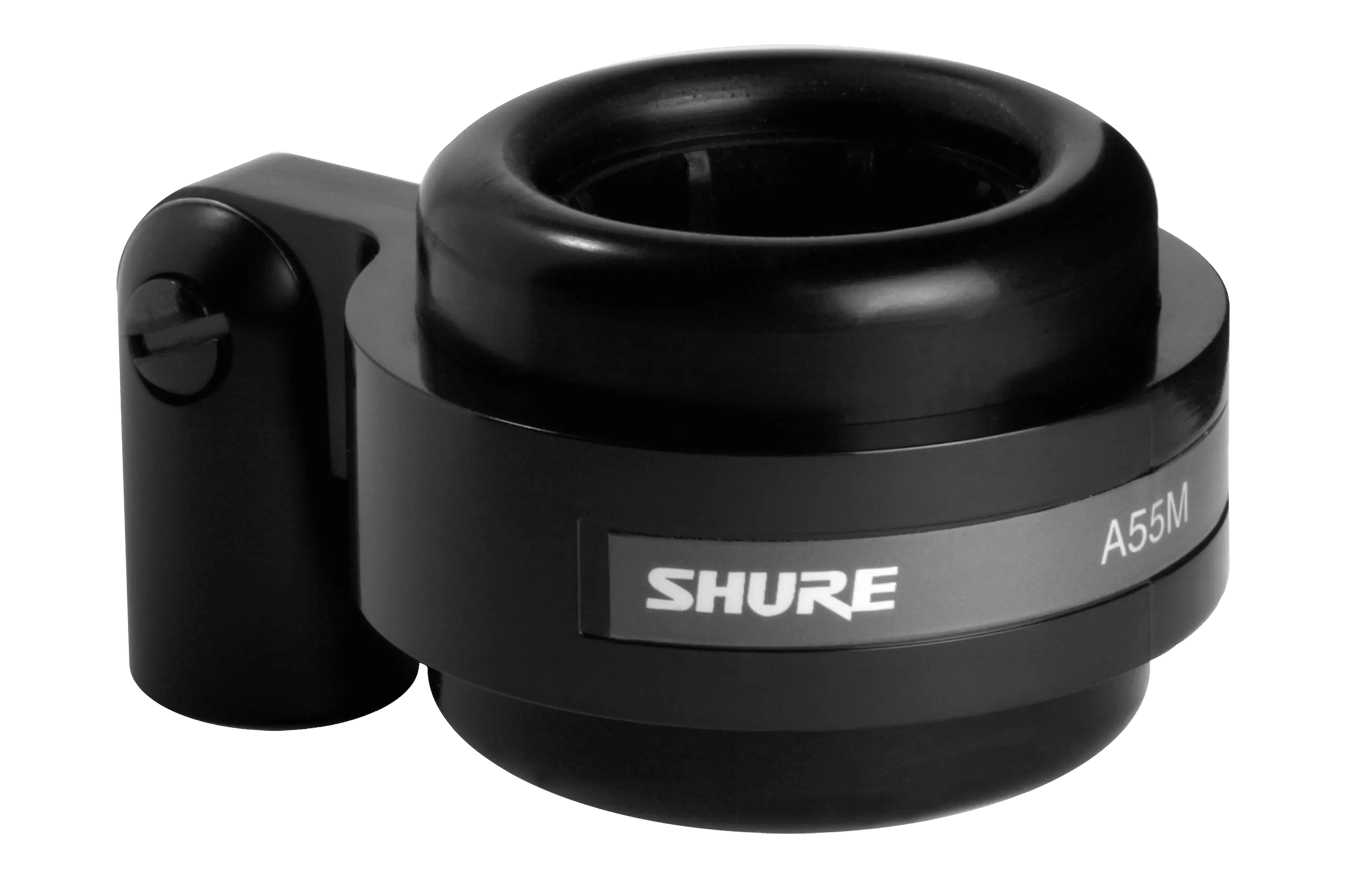
RFI Resistance
The thick steel case provides great RFI shielding. In RFI prone downtown Honolulu, no static or rogue radio stations were evident while using the SM57.
 Voiceover
Voiceover
I make instructional videos on music theory, music history and guitar. These subjects are straightforward to teach in person. However, video presentations of such topics require extensive graphics, video and layered audio—things that work best with voiceover narration rather than talking head. After hearing how good the SM57 sounded for spoken word, I tossed it into the fray with a couple voiceover and talking head projects.
In my "What is Harmony" video, I paired the SM57 with the Rode Streamer X (digital audio interface) for voiceover segments. For talking head, I recorded into a Tascam DR-60 MK II and synced audio in Final Cut Pro.
Final Cut Pro Timeline | All seven minutes of "What is Harmony?"
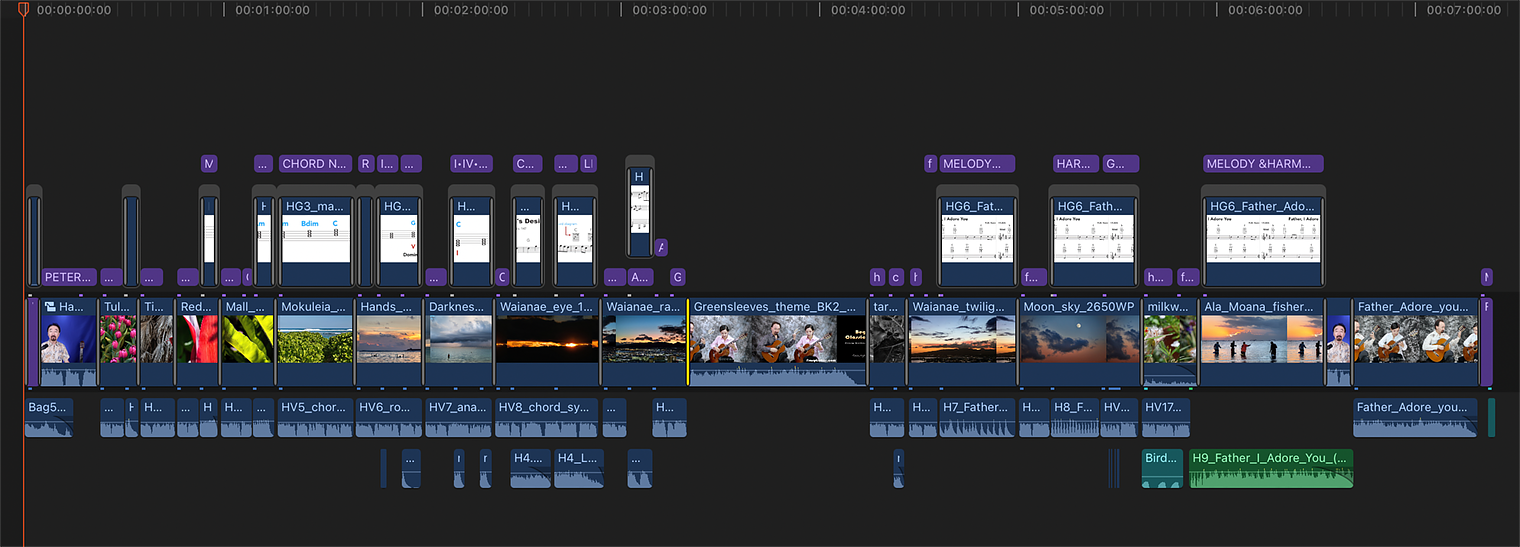
Speaking Distance
Shure recommends speaking into the SM57 from 2.5 cm (1") to 15 cm (6") from your mouth. About 10 cm (4") from the mic is the sweet spot for me. The 2.5 cm distance is favored by many singers due to the strong proximity effect—emphasis of low-frequencies—but isn't desirable for my speaking style.
In talking head segments, I didn't want the mic to cover my face so I spoke 15 cm to 20 cm from the mic. The result was a brighter and less bassy tone compared to the voiceover. I prefer the closer (10 cm) tone. An out of frame shotgun mic would have been a better choice for avoiding "mic face." Maybe next time!
Processing
No audio processing was used other than normalization. Both the Rode Streamer X and Tascam DR-60 MK II had plenty of preamp gain for the SM57.
What is Harmony? | Professor Peter Kun Frary (7:30)
One of the things I love about the SM57 is how forgiving it is of less than perfect vocal technique. With the Shure A2WS installed, I had no problems with plosives and mouth noises. Sibilance, while present, was mild and well controlled. Isolation from off-axis sound is amazing. Next door, six meters away, AC was rumbling and yet not a peep made it onto the track.
Tools and Software
To create "What is Harmony" required extensive preparation. My voiceover script was recorded in Twisted Wave and trimmed and normalized. Video clips were shot on a Canon R6 MK II. Music scores were created in Finale and edited in Photoshop. Background images were shot on Canon R, R6 MK II and R7 cameras and edited in Photoshop and Lightroom Classic. Guitars and ukuleles were recorded on a Tascam DR-60 MK II with a pair of Neumann KM 184 in X-Y stereo configuration and edited in Logic Pro. Finally, with some hair-pulling, all these components were synced and assembled in Final Cut Pro.
 Sound Comparisons
Sound Comparisons
If you're interested in how the SM57 compares to other mics, below are audio samples of most of the mics I've used for voiceovers. For the samples, I spoke from 8 to 10 cm away. Microphones were mounted on a boom clamped to a computer desk in a partially treated room. I recorded into TwistedWave at 48 kHz and 24-bits. Gain was staged at -12 dB. No processing or normalization was used. Mics were fitted with a foam pop filter unless otherwise noted.
If not interested in the mic comparison, click here to jump to the Final Blurb.
Shure SM57
The Shure SM57 was recorded through the XLR port of the Rode Streamer X with gain at 67dB.
For this track, I spoke straight into the mic from 10 cm away. If you prefer less brightness, speak offset to the capsule. Sound is warm, smooth and easy on plosives. SM57 tone is more flattering for my voice than the Rode PodMic USB. Rejection of off-axis sound is excellent.
The SM57 retails for $99 USD.
AKG C3000B
The AKG C3000B, circa 2009, is a large diaphragm side-address condenser mic. It remains in production as the AKG C3000 and sells for $350 USD. The lower treble frequency bump makes it too bright for classical guitar. On the other hand, that bump makes it a good mic for spoken word, exhibiting clarity, detail and a bit more treble bite than the PodMic USB.
The C3000B was recorded through the XLR input of the Rode Streamer X with gain at 46 dB.
Lewitt LCT 240 Pro
The Lewitt LCT 240 Pro was plugged into the XLR input of the Rode Streamer X. Gain was set to 47 dB. This is a small diaphragm side-address condenser mic designed for home studios. It's an attractive and compact design, especially the effective yet space saving magnetic drop-in pop filter.
The 240 Pro flatters my voice with a pleasing but somewhat bright timbre and above average clarity and legibility of words. With the pop filter, plosives and sibilance were well controlled. Without the pop filter, the 240 Pro sounds like a wind storm. Wear protection!
While the bright character makes for clear and understandable words, it also makes the 240 Pro more prone to picking up background sounds than many of the mics here, save for the Neumann TLM 102.
Without accessories, the 240 Pro is priced at $100 USD. The shock mount and pop filter kit clock in at $159.
Neumann KM 184
Obviously, the KM 184 is not designed for close miking of spoken word: no protection from plosives and moving air. That doesn't mean the KM 184 won't sound good for spoken word, but use of a pop filter is mandatory.
The KM 184 is a sensitive and dynamic mic—why I like it for instruments—but with only a foam windscreen, plosives were out of control. I nixed plosives by speaking offset about 30 degrees but didn't like the duller sound. Finally, I added an external pop filter and that worked well enough to squeeze out a test track. The KM 184 is flattering for my voice: smooth, clear and very clean. As I experienced with guitar, off-axis rejection of sound is excellent.
Would I use this mic for voiceovers? Probably not. It is extremely sensitive and requires good vocal technique to keep plosives and dynamics under control. Somebody with better voice technique may find it doable but the KM 184 cramped my style. With that said, the KM 184 is my pick for best spoken word sound among my mics. My favorite for solo guitar tracks as well.
For this recording, the KM 184 was plugged into the XLR port of the Rode Streamer X. Output from the KM 184 is robust: gain was set to only 36 dB, lower than my other condenser mics.
Music track recorded with two KM 184 in a X-Y stereo configuration aimed at the bridge. "Through the Eyes of Love" played on a Romero Creations 'ukulele by yours truly:
Neumann TLM 102
One of my favorite mics for recording classical guitar is the Neumann TLM 102, a large diaphragm side-address condenser mic. Pointed at the bridge, it renders a beautiful and sweet plucked string tone. For guitar, it needs little or no EQ.
While great sounding for voice—smooth and natural in character and flattering to my voice—it is extremely sensitive to mouth sounds and puffs of air. I used a foam filter from the Deity VO-7U to help control plosives. That wasn't enough so I added a clamp-on pop filter but still had to be careful while speaking.
The TLM 102 is also more sensitive than average to vibrations from the floor, computer fans and off-axis sounds! I used a clone of Neumann's shock mount to help nix vibrations. It is unusable without a shock mount.
I recorded the Neumann TLM 102 through the XLR input of the Rode Streamer X. Gain was set at 46 dB. The TLM 102 is at its best in an acoustically treated and soundproof room.
Currently, the 102 retails for $750 USD.
Rode NT1 Signature Series
The Rode NT1 Signature Series Studio Condenser Microphone (5th generation), circa 2024, is a large-diaphragm side-address condenser mic. It's been in production for many years, existing in multiple variants. It currently sells for $159 USD. It has a smooth and fairly flat response, a slight bump in the upper frequencies, and exhibits excellent clarity, detail, and slightly less bass than the 4th-generation NT1 that preceded it.
The NT1 was recorded through the Rode Streamer X with gain at 35 dB.
Rode PodMic USB
I plugged the XLR output of the Rode PodMic USB into the Rode Streamer X and set gain to 63 dB. The Rode PodMic, along with the Shure SM7B, rule over the video blogging and podcast kingdoms. Of course, they sound good and offer excellent isolation but also are large and visually impressive status mics.
Although vocal tone sounds nice, I struggled with plosives and sibilance when using the PodMic USB. Somehow the Shure SM57 and 849 have fewer problems in this area. An external pop filter and 30 to 45 degree mouth angle were required to keep plosives and sibilance under control. I prefer the tone speaking straight into the mic but suffered too many do-overs.
The PodMic USB retails for $200 USD.
Sennheiser MKE 600
That was the unprocessed sound of the Sennheiser MKE 600 recorded into an iMac Pro using the XLR input of the Rode Streamer X. I spoke directly into the MKE 600—no offset—from 10 cm (4 inches) away. At that distance the proximity effect is apparent but still sounds good, similar in character to the MKE 400 but with more bass. Offset speaking of 25 to 45 degrees at close distance rolls off highs a little but not as severely as the MKE 400.
Spoken word on the MKE 600 sounds best at 30 cm (12") or closer. For me, the sweet spot is from 10 to 15 cm. At about 12 cm (5 inches) it yields a noticeably clearer, brighter and less bassy sound. For this sample, I used the high pass filter to reduce the rumble of a nearby AC unit and spoke from 12 cm away:
It helped reduced the rumble but ate too much of the bass in my voice.
While the MKE 600 has excellent off-axis rejection, it is extremely sensitive and picks up distant sounds directly in front of the capsule more readily than the MKE 400 and other mics I own. Careful mic placement is critical. The MKE 600 behaves like a traditional shotgun mic rather than an arm's length video blogger mic, and sounds good boomed 25 or 30 cm above a talking head.
The MKE 600 lacks the integral blimp-like housing used on the MKE 400 and 440. It needs a foam windscreen if speaking at close distances. With windscreen installed, the MKE 600 demonstrates excellent control of plosives and sibilance.
This mic retails for about $330 USD but is often discounted.
Rode X Streamer | Mounted on a Manfrotto arm for easy port access.
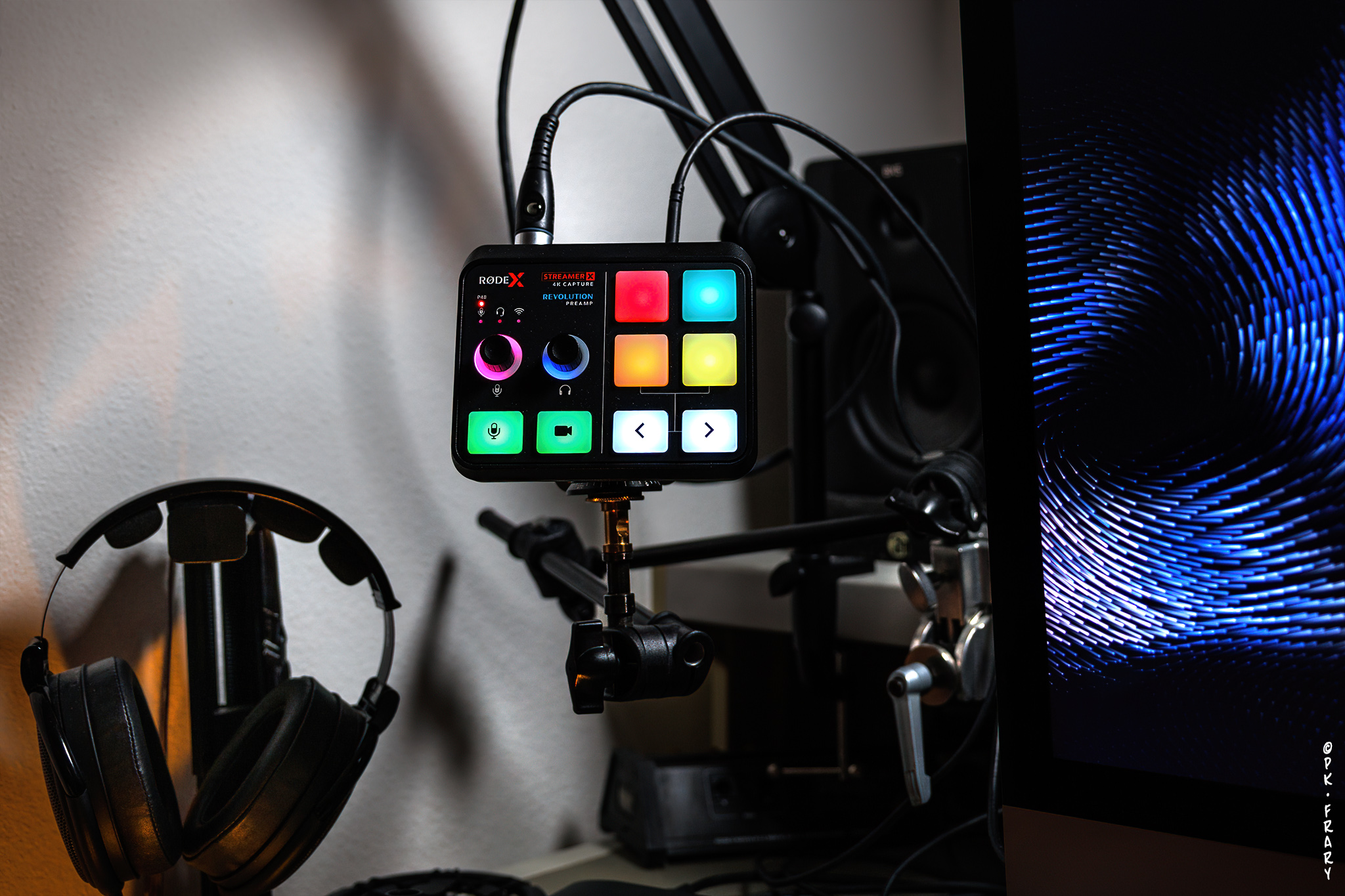
Shure 849
For this recording, I plugged the 849 into the XLR port of the Rode Streamer X interface. Gain was set to 46 dB.
The Shure 849 was surprisingly flattering for my voice: smooth, warm, clear and very clean. With a foam windscreen or pop filter, it is extremely forgiving of plosives and small puffs of air. Because it was designed for isolating and miking stage instruments, off-axis sound rejection is excellent.
Among the mics I tested, the 849, SM137, KSM8 and Beta 57A were the only mics that picked up no vibrations or hum from my hard drives and nearby AC units. These mics were designed for hand held use and, thus, have internal pneumatic shock mounts.
Shure Beta 27
That was the sound of the Shure Beta 27, a large diaphragm side-address FET condenser mic with high pass filters and pad. It differs from other 27 series due to a supercardioid polar pattern, rather than cardioid, and a nearly flat frequency response instead of the typical Shure treble EQ bump.
That flat frequency contour makes it ideal for instruments. Indeed, it sounds natural and smooth for guitar and ukulele. I found it natural and balanced for spoken word. The Beta 27 has more going on in the deep bass than most mics. Indeed, it picks up bass guitar, low brass and kick drums extremely well.
While mounted on a desk boom arm, vibrations and hum from my six external hard drives leaked on to the tracks. Shure claims that the Beta 27 has an internal shock mount but it is not as effective at nixing vibrations as their stage mics. Like the PodMic USB and the Neumann TLM 102, I had to unplug my backup drives to get a clean track. The Beta 27 needs a shock mount for desktop use.
Shure Beta 27 with High Pass Filter
For my speaking voice, not much is going on below 80 Hz and, set flat, the Beta 27 has a bit of the "big bottom" sound. Clarity of my voice increased slightly by using the built-in 80 Hz high pass filter:
The Beta 27 was recorded through the Rode Streamer X with preamp gain at 50 dB. I spoke straight into the capsule from about 15 cm (6 inches). The mic’s 3-layer mesh grille did a good job of nixing plosives and mouth noise. An external pop filter was not used. Sibilance was well controlled.
For this sample, I used the Shure A27SM - ShureLock Rubber Isolated Suspension Shock Mount. And it made a major improvement in isolating the Beta 27 from my six external hard drives. Shure should have included the A27SM with the Beta 27 (they do with its near twin, the SM27).
The tight supercardioid polar pattern made for above average off-axis rejection of sound, besting most of my mics. Unlike the similar SM27, the Beta 27 is ideal for recording on stages and untreated rooms.
Shure Beta 27 with Guitar
Here's a guitar solo I played on a 1990 Jose Ramirez 1A. The Beta 27 is positioned about 20 cm from the treble side of the bridge and does a great job. However, I prefer the sound of small condenser mics—well, the Neumann KM 184—for classical guitar. Plus, I'd need two Beta 27 for stereo recordings! Here's my "Thoughts for Monday" (improvisation):
This mic retails for about $400.
Shure Beta 57A
You just heard the sound of the Shure Beta 57A plugged into the XLR input of the Rode Streamer X. Grain was set to 63 dB.
Beta 57A isolation from off-axis sound is excellent: better than the Rode PodMic USB and on par with the Shure 849 and SM137. The 57A features Shure's internal pneumatic shock mount to help smooth away vibrations and handling noise.
With the Shure A57AWS - Locking Foam Windscreen installed, resistance to plosives is highly effective, easily besting the Rode PodMic USB in this regard. Without the A57AWS, it is plosives galore albeit better than a nude SM57.
Sound is smooth, clear and sensitive for a dynamic mic. Clarity and legibility of words is above average—can cut through a busy sound track without cranking gain too much. The Beta 57A has a brighter character and more extended frequency range compared to the darker voiced SM57.
Although the Beta 57A is slender and traditional in appearance, the muted matte blue finish and matte silver grill are more upscale in appearance compared to the plain jane SM57.
The Beta 57A retails for $150 USD.
Shure KSM8
The KSM8 was recorded through the XLR port of the Rode Streamer X with gain at 57dB. For this track, I spoke straight into the mic from 10 cm (4 inches) away. A pop filter or foam windscreen wasn't used.
Although designed as a vocal mic, the KSM has a significantly flatter frequency profile than the SM58. I love its more natural rendering compared to typical vocal and broadcast dynamic mics.
I don't have a shock mount for the KSM8, so I expected plenty of noise and vibration when testing it on a boom arm clamped to my computer desk. Amazingly, unlike most of my other mics, the KSM8 proved to be immune to hard drive and fan vibrations. Shure's user guide claims that an "advanced internal pneumatic shock mount and the Diaphragm Stabilization System (DSS™) work together to prevent handling noise." Apparently it also nixes vibration better than my other internal pneumatic shock mount equipped Shure mics.
This tough but beautiful mic sounds great: warm, smooth and easy on plosives and sibilance. Off-axis sound rejection is excellent. Among all my dynamic mics, I found the KSM8 the most flattering for my voice. It is also easy to work with, not too gain hungry, has a big sweet spot and tolerates close sound sources with only a slight but pleasing proximity effect.
The KSM8 is pricey, retailing for $399 USD, albeit I snagged one on sale for $319.
Shure SM137
For this recording, I plugged the Shure SM137 into the XLR socket of the Rode Streamer X and set gain to 47dB. The Shure A3WS Foam Windscreen was installed. Like the Beta 57A and 849, the SM137 has excellent rejection of background and handling noise. Indeed, Shure's pneumatic shock mount system smooths away minor vibrations and makes hand held use practical. Albeit slightly brighter, it sounds similar and looks like the Shure 849. The SM137 retails for $190 USD.
 Final Blurb
Final Blurb
Why on earth did I use the SM57 for spoken word when there are many dedicated vocal microphones out there? Like many musicians, I already owned a SM57 and repurposed it for spoken word by simply adding a pop filter. Most importantly, it sounds good. For my voice, sound quality surpasses the popular Rode PodMic and nips at the coattails of the iconic Shure SM7B.
I enjoyed working with the Shure SM57. For spoken word, especially in untreated rooms typical of home studios, it excels with solid tone, great isolation and ease of use. Unlike my Neumann microphones, use of a single pop filter nixes plosives effectively and makes unfettered speaking a snap. Plus, I found the SM57 tough to clip with any reasonable amount of gain. While not my first choice for classical guitar, it is a versatile mic, suitable for most instruments, overheads and spoken word when used with a pop filter.
Please support this website by purchasing the Shure SM57 at Amazon.
Koi Rampage | Canon EOS 77D and EF-s 18-55 3.5-5.6 IS STM

 Features & Specs
Features & Specs
- Dynamic (moving coil)
- Max SPL: ranges from 150 db to 190 db dB depending on frequency
- Output Impedance: 310 Ω
- 40 Hz to 15 kHz frequency response
Physical
- XLR connector
- Dimensions: 157 mm x 32 mm (24 mm at the XLR end)
- Dark gray, enamel-painted, die-cast steel body with polycarbonate grille and stainless steel screen.
- Weight: 284 g
Included accessories
Soft pouch and clip
Optional Windscreen
Shure A2WS (foam with metal ring and screw lock)
Country of Origin
USA or Mexico (depending on year of production)
1965 to current
Instruction Manual
Price
$99 USD
Website
09/28/2024


